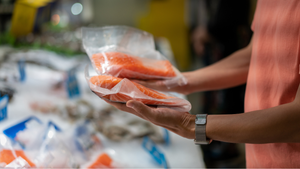Trump Administration Reaches Out to Retailers About SNAP ProposalTrump Administration Reaches Out to Retailers About SNAP Proposal
The Lempert Report: Many have reacted negatively to the new proposal.
January 1, 2018
Since Feb. 13, Agriculture Secretary Sonny Perdue and the Director of the Office of Management and Budget Mick Mulvaney first floated their concept of “America’s Harvest Box” as a way to reduce costs and the number of people on food stamps (or SNAP, the Supplemental Nutritional Assistance Program). Just about everyone has criticized the idea, and it’s the administration’s own fault. The mishandling of how to explain this idea might well kill what could have been an idea worth exploring.
The budget requests $19 billion for USDA (excluding changes in mandatory programs), a $3.7 billion or 16% decrease from the 2017 enacted level.
The budget proposes a bold new approach to nutrition assistance that combines traditional SNAP benefits with 100% American-grown foods provided directly to households, and focuses administrative reforms on outcome-based employment strategies. Currently, approximately 43 million Americans receive monthly SNAP benefits. The administration is also requesting comments for ideas on how to shrink the roles of people on SNAP (you have until April 9, 2018, to add yours).
“America’s Harvest Box,” as described by the agriculture secretary, would include shelf-stable milk, juice, grains, ready-eat-cereals, pasta, peanut butter, beans, canned meat, poultry or fish, and canned fruits and vegetables, and would account for approximately half of one’s SNAP benefits. I would argue that while some of the ingredients or canned products may have come from a harvest, the name certainly implies an abundance of fresh foods. The remainder of the SNAP benefits would still be distributed on EBT cards, which recipients could continue to use at farmers markets, many of which double the value when one buys fresh produce.
Delivering this box to a recipient’s home is expensive, as Blue Apron, Peapod and others in the food delivery business have learned, and can be a logistical nightmare—especially in some communities where leaving a box on a doorstep or unsecured area might be an invitation for theft, as well as visually pointing out to neighbors who is relying on government assistance.
There already exists a model for this program. It’s the Senior Kits (CSFP) that provides monthly food assistance to low-income seniors through food banks, which now serves over 600,000 seniors across the nation but has come under fire for a lack of infrastructure, including delivery and the assortment of the foods themselves.
Finally, the administration has reached out to the people who know food best—the food industry—and is talking to retailers about being involved. Estimates show that anywhere from 13% to 30% of independent retailers' sales come from SNAP recipients. AlixPartners, a retail consulting firm, estimates that Walmart, the nation’s largest food retailer, could lose up to $70 billion in sales over the next 10 years if this program becomes a reality. Walmart food sales in 2013, according to AlixPartners, included 18% of all food stamp redemptions in the U.S. The administration finally started talking to grocers to explore how they can be involved in such a program, and is asking for their ideas—something one could argue should have happened months before the concept was disclosed.
You May Also Like




